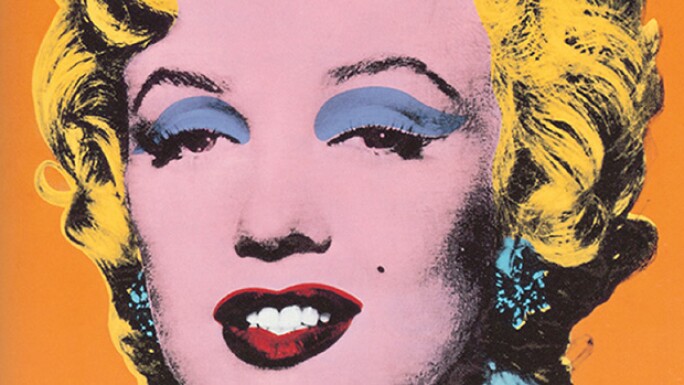
Andy Warhol's Orange Marilyn made a splash in 1998 when it sold at Sotheby's for $17.3 million.
21 Days of Andy Warhol is Sotheby’s three-week celebration of the essential 20th century artist with one-a-day stories and videos about Warhol’s origins, influences, inspirations, all leading up to the sale of important Warhol pieces in our Contemporary Art Evening auction 13 November.
NEW YORK - Of all Andy Warhol's celebrity subjects, none seem more perfectly emblematic of how the artist perceived and synthesised America than Marilyn Monroe. Warhol saw in Monroe all the promise, beauty, pleasure, fame and tragedy that 1960s America was capable of realizing. In his Marilyn portraits – which he began shortly after Monroe's death, in August 1962 – it's impossible to locate what one might call the truth of the subject. By design, Warhol appears to welcome the many, mask-like guises that at once seem to obscure, protect and yet also define Monroe: actress, sex symbol, innocent ingenue, Hollywood product. For a 1964 series of 40-by-40-inch portraits of Monroe, Warhol turned to the ad man's brash, saturated palette (one that he, the accomplished fashion illustrator, knew well) to colour the hair, eyelids and lips of the fallen star, as well as the field around her floating, disembodied visage. This is the series to which belongs the ravishing Orange Marilyn.
Orange Marilyn came to Sotheby's in 1998, and was sold in its evening sale of contemporary art on 14 May. The night proved a huge success, thanks in large part to the $17.3 million sale of Orange Marilyn, which at the time set a new record as the highest price paid for a Warhol artwork. (Sotheby's estimate was $4 million to $6 million.) The evening's $35.7 million in sales also marked Sotheby's biggest opening-night auction of contemporary art in nearly 10 years. "It was the moment of drama for that sales season," says Leslie Prouty, a senior specialist at Sotheby's who's been part of the Contemporary Art Department since 1982.
"It's quite simply one of the most coveted series for him, these larger, 40-by-40-inch portraits of Marilyn with the coloured background," Prouty goes on. "There are not that many." Within the series of 40-inch square Marilyn portraits with the brightly coloured backgrounds, Prouty says Orange Marilyn is "just one of the sexiest colours and one of the best screens from the series."

Andy Warhol in front of two paintings from his Marilyn series. Photograph by Donald Getsug
Furthermore, the work has a significant provenance. Prouty says, "It was very well known for having been in a collection of a gentleman named Leon Kraushar." Kraushar was a prolific and prescient collector of Pop art who died suddenly of a heart attack in the late 1960s. At one time he owned not only Orange Marilyn, but also Warhol's Red Jackie and Green Liz. "For someone to have all three of the celebrity portraits in the 40-by-40 size, hanging in his bedroom side by side, is just a knock-out moment in retrospect," Prouty says. (In 1965, Kraushar famously appeared in a Life magazine photo spread that showed him in his bedroom, with all three works hung above his bed.) Following Kraushar's ownership, Orange Marilyn went on to become part of the well-known Stroher collection, in Germany.
In 1989, a work similar to Orange Marilyn called Shot Red Marilyn sold at auction for $4 million. "In a way, that was the basis for our estimate, and an example of how trusting the process and not making the estimate lead the market but letting the market set its own level is sometimes the charm for really getting competitive bidding," Prouty says. "This one was a pretty extraordinary advance over its estimate. But it had everything to do with the painting, its beauty, its seductiveness and its importance. It was a thrilling moment."
Tomorrow: Andy and Self-Portrait